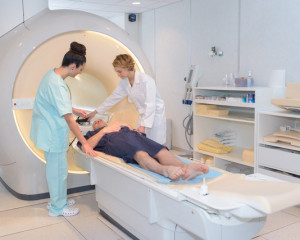People who suffer from low back pain visit their doctor or go to the local emergency room in high numbers. When you experience severe back pain, you may think something is wrong with your spine. To ease your concerns, you could request an x-ray or an MRI from your doctor. Nevertheless, it is likely that a spinal imaging test is not always necessary in most cases of lower back pain.
Lower back pain often improves within a few days or weeks at the most. Low back pain can be caused by a strain, sprain, or poor posture. These causes can induce extreme pain and can limit your daily activities, yet they are often easily treated without the need for tests and scans. If you're unsure if you need an MRI for your lower back pain after an accident, contact us at DOCS4PI. We have a network of qualified medical professionals that can determine if you need an MRI and the best course of treatment.
But first, what are the causes of lower back pain and how can an MRI help? Continue reading to learn what an MRI is and the possible advantages of having one if you have low back injury. We'll also discuss the risks and disadvantages as well. To help you find specific information to help you make your decision on what to do next we've broken it down into these six sections:
- What Causes Low Back Pain
- What is an MRI
- The Advantages of Having an MRI
- The Disadvantages of Having an MRI Scan
- When To Have an MRI Scan
- Can an MRI Detect Low Back Injury?
What Causes Low Back Pain
Most low back pain and stiffness can be attributed to strained muscles and ligaments. A non-surgical treatment usually works well for this type of back problem. An MRI usually isn't helpful in cases like these. A compressed spinal nerve can cause sciatica symptoms, such as sharp pain down the back of the leg or side. There may also be feelings of weakness or numbness caused by pressure on the nerve. There could be a herniated disc or protrusion in your spine causing this. It normally gets better within two months.
Other more serious causes of back pain are infections, tumors, and cancer. There are a small number of cases where low back pain is caused by a serious condition or nerve-related issue. MRI images can be used to identify the condition and plan treatment for those causes.
Here are some of the most common causes of lower back pain:
- A lumbar herniated disc. Inflammation, as well as nerve compression, can cause nerve root pain from the herniated portion of the disc. The stiff disc wall is also richly supplied by nerve fibers, so a tear through the wall can cause severe pain.
- Degenerative disc disease. When we are born, intervertebral discs are full of water and at their healthiest. As time goes on, they become dehydrated and degenerate. Loss of disc hydration may cause the disc wall to break down, which could lead to a herniation or to the disc wall collapsing, causing pain. The disc can also collapse, causing spinal stenosis.
- Facet joint dysfunction. The lumbar spine has two facet joints at each disc segment. These joints contain cartilage between the bones, and they are surrounded by ligaments, which are richly supplied with nerves. Sometimes these joints are painful by themselves, or in combination with disc pain.
- Osteoarthritis. The condition is caused by the degeneration of disc and facet joints, which causes pain, inflammation, instability, and stenosis at a single level or several levels of the lower back. Spinal osteoarthritis occurs most commonly in middle age and is slowly progressive. It is also known as degenerative joint disease or spondylosis.
- Trauma. Trauma such as a fall or a collision can cause acute spinal fractures or dislocations. Back pain that occurs after trauma, such as a car accident, should be examined by a doctor.
- Compression fracture. This type of fracture generally occurs due to weak bones, such as osteoporosis, and is more common in older people. This fracture usually occurs in the cylindrical vertebra and causes sudden pain.
What is an MRI?
An MRI, short for Magnetic Resonance Imaging, is one form of testing that is extremely useful in detecting issues within the body, similar to x-rays. MRIs work differently from x-rays in several ways, for example they can show images of non-bone matter as well. An MRI can show disc material in the spine. That's why it's so common to use MRIs in car accidents, since the discs are often the cause of pain and the doctors need to identify it to properly treat the injury.
A magnetic field is used to excite hydrogen atoms around the spine, and that energy is then picked up on an MRI scanner. Humans are predominantly composed of water (consisting of two parts hydrogen), so MRI scans show more detail of the spine's anatomy.
MRI scans do not contain radiation, unlike x-rays, so they may be performed during pregnancy. An MRI scan is not recommended for people with pacemakers implanted in their heart as the magnetic field may cause it to malfunction. People who work around precious metals should also get their eyes scanned beforehand to ensure they do not have any metal filings in their eye that could migrate during their scan and damage the eye.
The Advantages of Having an MRI
It may be important for a doctor to perform an MRI on a patient who has suffered neck, spinal cord, or back injuries because it will help them locate where your injuries are coming from. If your doctor knows the location and because of your injuries, he can use less invasive techniques to treat them. The MRI is essential to your doctor deciding if surgery is recommended and if so, where and how. If the injury is very serious, then an MRI will be crucial.
The Disadvantages of an MRI Scan
Medically, there is no negative impact of having an MRI. In fact, they are a great way for your doctors to get the information they need to diagnose and treat your injury. Legally and financially speaking, an MRI may not make sense. MRIs are very expensive. Even with health insurance, a patient may have to pay more than $1,000 to have the test performed. It is likely well worth the cost if it is done for medical reasons. On the other hand, if it's just for a personal injury case, then it may not be necessary. The reason for this is that settlements do not always increase based on what an MRI shows.
When to have an MRI Scan
An MRI scan is usually recommended for patients with general back pain and a suspected lumbar disc herniation early in the course of their symptoms. The reason for this is that surgery for a lumbar disc herniation results in relatively little collateral damage and leads to fast recovery for patients. Patients with lower back pain generally require lumbar spinal fusion surgery. This back surgery has a high risk of unexpected side effects (morbidity) and takes a long time to heal.
In order to determine if the pain will improve with conservative (nonsurgical) treatment, physicians often recommend waiting 3 to 6 months before having an MRI (magnetic resonance imaging). If an MRI scan is not going to affect a patient’s further treatment for back pain—both in terms of chiropractic, physical therapy and medication—it is a good idea to delay an MRI scan.
Can an MRI Detect Low Back Injury?
As found by the American Academy of Family Physicians, conditions related to low back pain are the fifth most common reason for hospital, clinic, and other healthcare facility visits. An MRI can be performed for a wide variety of reasons. If you are experiencing pain in your lower back, then a doctor may recommend an MRI to diagnose the source of your pain.
Doctors may also recommend lumbar MRIs before back surgery for patients. In these cases, the surgical team will review the results of the lumbar MRI and use that information to make plans for the operation.
Doctors may also use a lumbar MRI to:
- Ensure correct alignment of the spine
- Vertebrae or spinal cord abnormalities can be detected
- Assess the spinal cord and nerves for swelling
- Check for tumors near the spinal cord
- Monitor spine damage after an injury
- Monitor the spine after an operation
- Learn about the cause of back pain
Symptoms that may prompt a doctor to order a lumbar MRI include:
- A sudden back ache that occurs with a fever
- Lower spine injury or trauma
- Persistent and severe pain in the lower back
- Multiple sclerosis
- Leg pain that indicates disc herniation in spine
- Urinary or bowel incontinence
How Can DOCS4PI Help?
If you've been involved in an accident may contact DOCS4PI for more information on the best medical personnel for treatment. In order to ensure patients receive the best possible care, we carefully screen our doctors. They will be able to determine if getting an MRI scan will be necessary to assess your lower back injury. Our network of doctors can diagnose and treat injuries whether it is back pain, neck pain, knee pain, etc.





